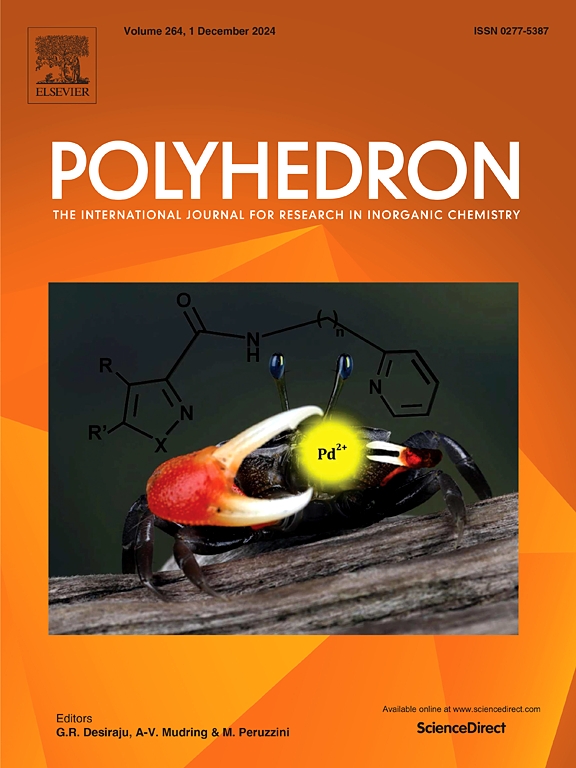Syntheses and single crystal structures of ruthenium complexes bearing NP and acac or hexafluoroacac ligands: Electrochemical properties and computational studies
IF 2.4
3区 化学
Q2 CHEMISTRY, INORGANIC & NUCLEAR
引用次数: 0
Abstract
The newly synthesized ruthenium(II) complexes: [Ru(N![]() P)2(acac)].PF6 (I) and [Ru(N
P)2(acac)].PF6 (I) and [Ru(N![]() P)2(acac-F)].PF6 (II), where N
P)2(acac-F)].PF6 (II), where N![]() P = 8-(diphenylphosphino)quinolone, acac = acetylacetonato anion and acac-F = hexafluoroacetylacetonato anion, have been isolated and characterized by FT-IR, 1H NMR, 13C NMR, UV–Vis and single crystal X-ray analysis. Both complexes assume distorted octahedral structures. Theoretical calculations on the geometries of both complexes using DFT/B3LYP method showed a good match with the X-ray crystal structures. The calculated UV–Vis spectra of both complexes are in agreement with the experimentally measured ones. Cyclic voltammetry conducted on both complexes showed a reversible oxidative for the Ru(III)/Ru(II) couple. However, complex (II) showed a cathodic shift due to the e-withdrawing effect of F-atoms on the acac-F ligand.
P = 8-(diphenylphosphino)quinolone, acac = acetylacetonato anion and acac-F = hexafluoroacetylacetonato anion, have been isolated and characterized by FT-IR, 1H NMR, 13C NMR, UV–Vis and single crystal X-ray analysis. Both complexes assume distorted octahedral structures. Theoretical calculations on the geometries of both complexes using DFT/B3LYP method showed a good match with the X-ray crystal structures. The calculated UV–Vis spectra of both complexes are in agreement with the experimentally measured ones. Cyclic voltammetry conducted on both complexes showed a reversible oxidative for the Ru(III)/Ru(II) couple. However, complex (II) showed a cathodic shift due to the e-withdrawing effect of F-atoms on the acac-F ligand.

含NP和acac或六氟acac配体的钌配合物的合成和单晶结构:电化学性质和计算研究
新合成的钌(II)配合物[Ru(NP)2(acac)]。PF6 (I)和[Ru(NP)2(acac-F)]。PF6 (II),其中NP = 8-(二苯基膦)喹诺酮,acac =乙酰乙酰丙酮阴离子,acac- f =六氟乙酰丙酮阴离子,已被分离出来,并通过FT-IR, 1H NMR, 13C NMR, UV-Vis和单晶x射线分析进行了表征。这两种配合物都具有扭曲的八面体结构。用DFT/B3LYP方法对这两种配合物的几何形状进行了理论计算,结果表明它们与x射线晶体结构吻合良好。计算得到的两种配合物的紫外可见光谱与实验测量值基本一致。两种配合物的循环伏安法表明Ru(III)/Ru(II)对发生了可逆氧化反应。然而,配合物(II)由于f原子在acac-F配体上的电子吸出效应而表现出阴极位移。
本文章由计算机程序翻译,如有差异,请以英文原文为准。
求助全文
约1分钟内获得全文
求助全文
来源期刊

Polyhedron
化学-晶体学
CiteScore
4.90
自引率
7.70%
发文量
515
审稿时长
2 months
期刊介绍:
Polyhedron publishes original, fundamental, experimental and theoretical work of the highest quality in all the major areas of inorganic chemistry. This includes synthetic chemistry, coordination chemistry, organometallic chemistry, bioinorganic chemistry, and solid-state and materials chemistry.
Papers should be significant pieces of work, and all new compounds must be appropriately characterized. The inclusion of single-crystal X-ray structural data is strongly encouraged, but papers reporting only the X-ray structure determination of a single compound will usually not be considered. Papers on solid-state or materials chemistry will be expected to have a significant molecular chemistry component (such as the synthesis and characterization of the molecular precursors and/or a systematic study of the use of different precursors or reaction conditions) or demonstrate a cutting-edge application (for example inorganic materials for energy applications). Papers dealing only with stability constants are not considered.
 求助内容:
求助内容: 应助结果提醒方式:
应助结果提醒方式:


